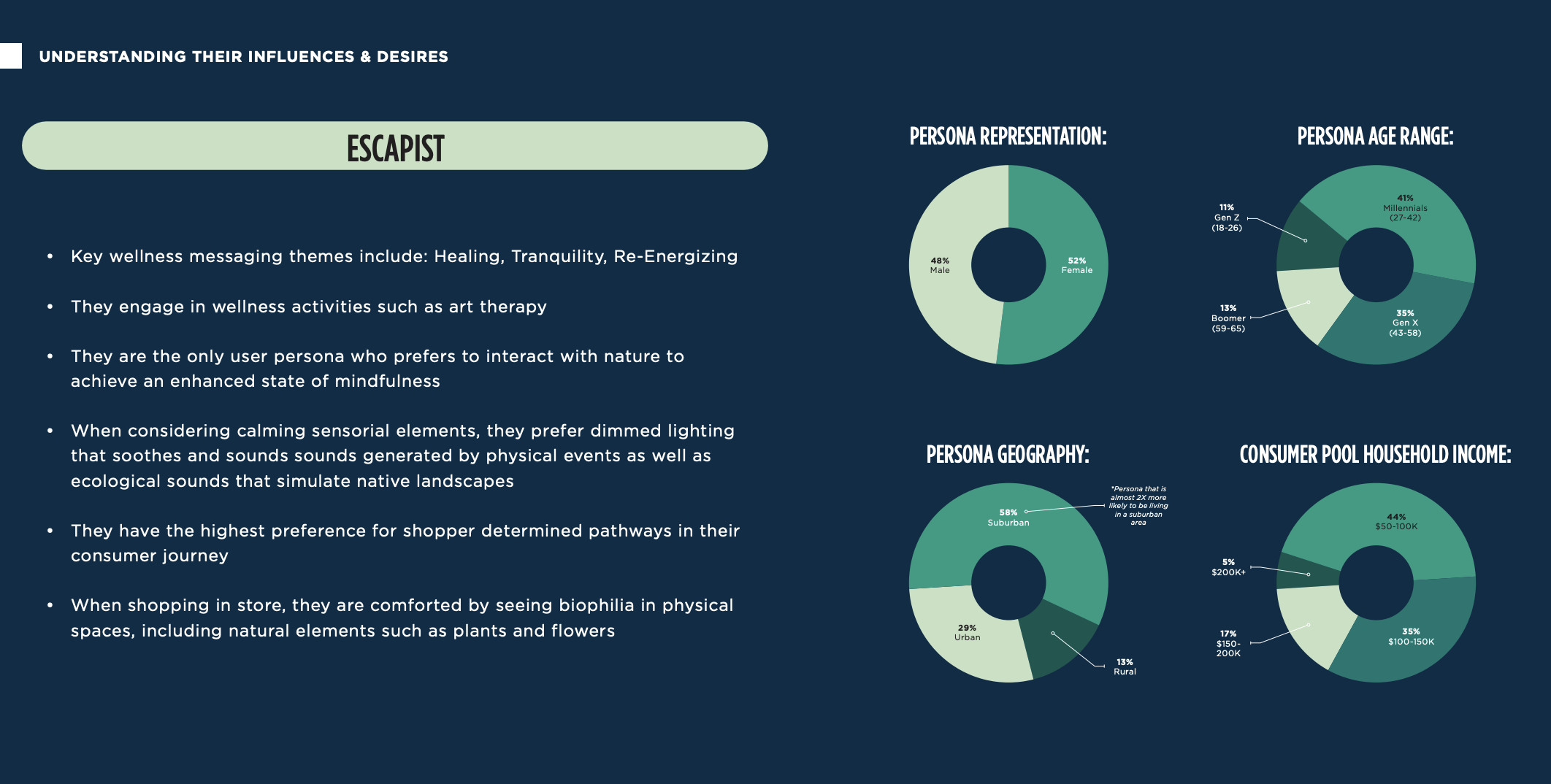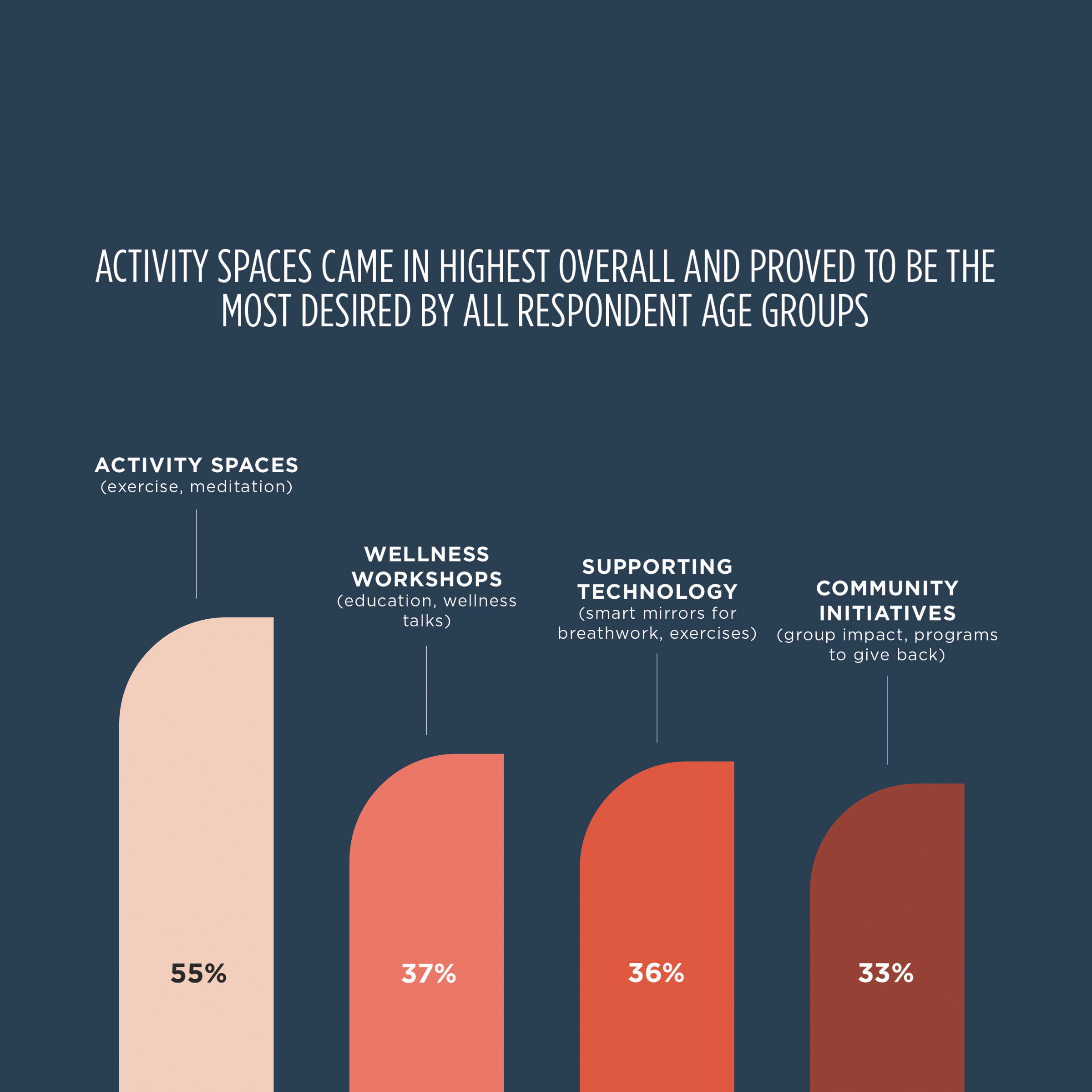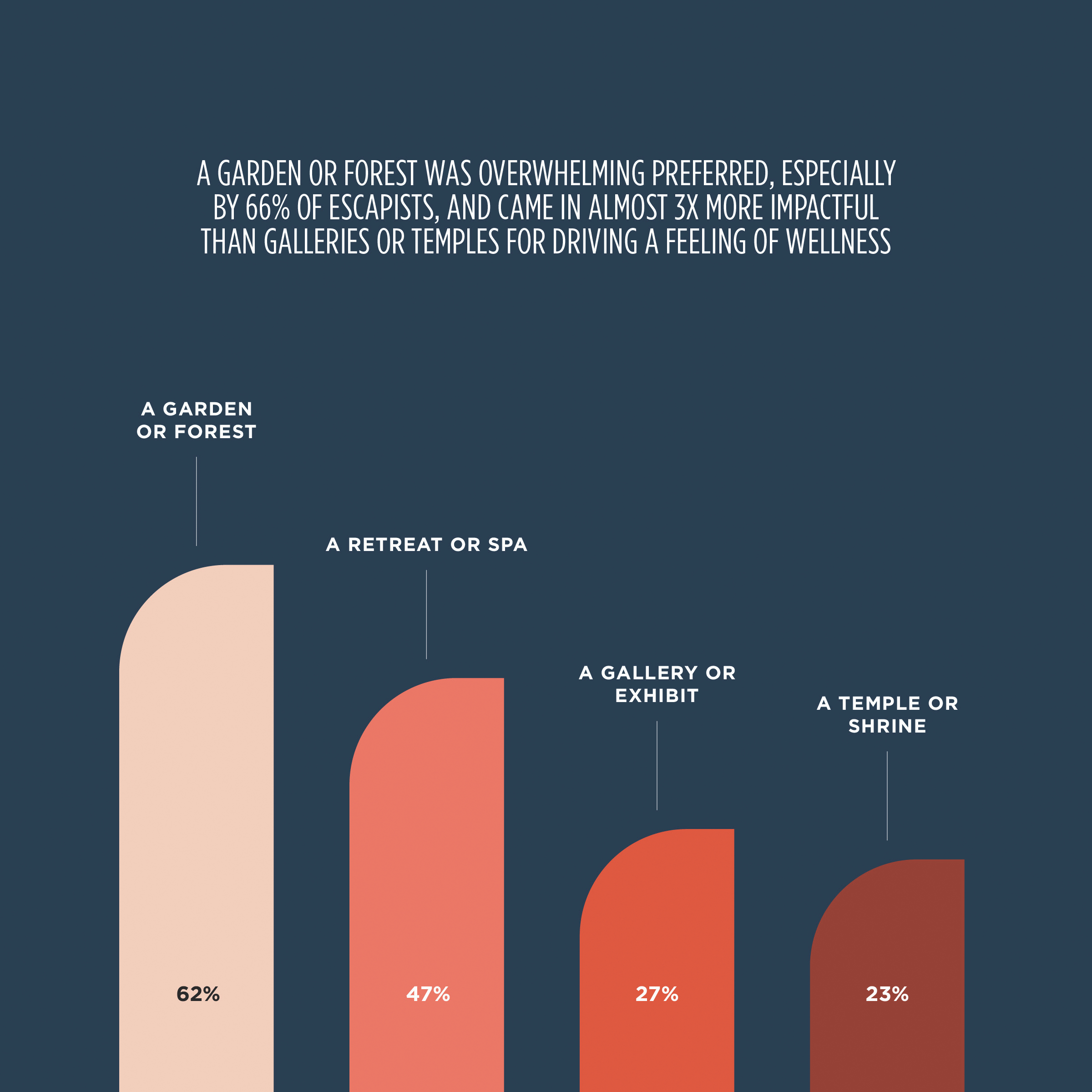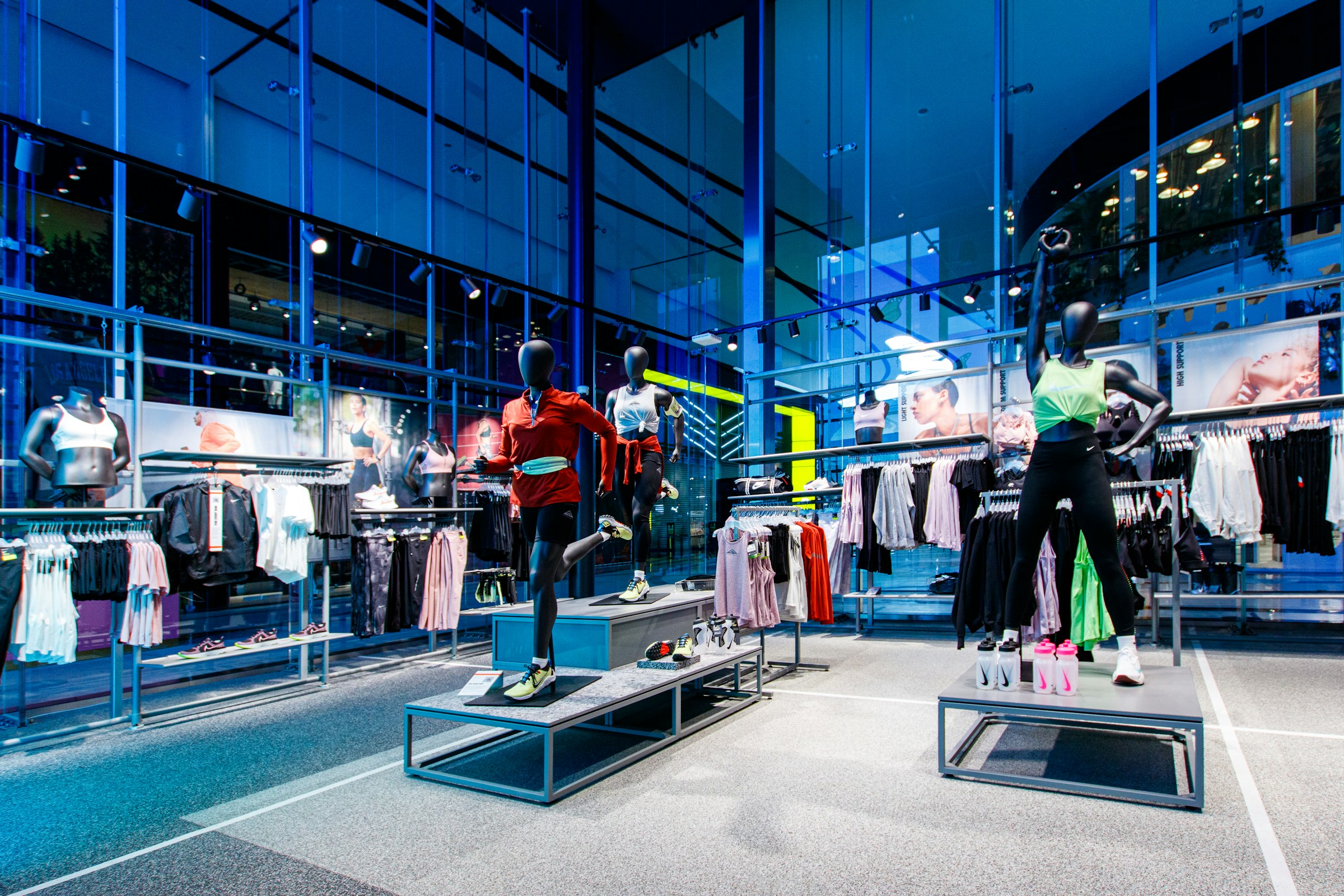Consumers are making lifestyle choices with wellness in mind, which ignites in them a feeling of purpose and a sense of motivation.
That’s the conclusion that the architecture and design firm MG2 draws from a survey of 1,182 U.S. adult consumers the firm conducted last December about their seeking healthier shopping experiences. (Download the full report.)
Nearly half of the respondents said they were aware of the effects that displays which communicate “wellness” have on their minds and bodies. About three in five respondents agreed that sounds generated by physical events—like waves or rain—coupled with natural light can establish a sense of calm. And about the same ratio preferred shopping environments with activity spaces, such as meditation or exercise rooms.
MG2’s report delineates the survey’s respondents by age, location (i.e., suburban, urban, or rural), gender, and household income. The report also groups the respondents into three categories:
- Pathfinders, who like to find, learn about, or develop wellness practices that will fit their lifestyles. Pathfinders accounted for 42% of respondents;
- Escapists, who look for relaxing or centering wellness outlets. This group represented 35% of respondents; and
- Ritualistics, who are committed to wellness routines that address their mental well-being on a scheduled basis.
For many, wellness in retail design equates to calm
The survey elicited responses that accentuated the range of meaning that “wellness” now encompasses. For example, 54% identified physical exercise, like running or yoga, as a wellness practice that enhances mindfulness. When it comes to enhancing emotional wellness, 48% of the survey’s respondents cited personal spaces for meditation or relaxation.
Indeed, “healing,” “tranquility,” and “re-energizing” were the top three themes cited for brands to emphasize in a consumer-focused wellness experience.
When taking a wellness-driven journey, Pathfinders prefer predetermined routes, as do consumers within the 27-43 and 43-49 age groups, whereas Escapists want to determine their own paths. (Ritualistics split down the middle.) All but the Baby Boomer cohort prefer visual messaging cues that help them navigate a wellness journey.



Knowledge about a product or service’s wellness characteristics and its effects on a consumer’s body and mind was deemed important information sought by the greatest percentage of respondents. It’s worth noting, too, that more than one-third of Generation Z consumers wants to know how a product will factor into their daily routines. “Brands and retailers have the ability to establish greater trust with their consumer audience by communicating these details, providing a deeper sense of confidence when deciding to invest in a product or service in support of their wellness journey,” the report states.
Sound, smell, and sight were identified by respondents as the three top integrated in-store senses for memorable experiences. And among the myriad “sensory scapes” that a shopping environment can present, sounds generated by physical events combined with natural light were the mostly likely to add a sense of calm for consumers, followed by ecological scenes and sounds that simulate native landscapes.
Synchronized music and lighting, on the other hand, ranked highest among the sensory scapes that would best add a sense of stimulation within consumers.
Lighting and tech can boost a retail store’s wellness ambience
“You can’t put a price tag on what delivers health and happiness,” says the report, which found that 85% of respondents differentiate wellness-driven retail experiences from conventional shopping.
For Ritualistics, what separates one from the other is how the experience enhances their daily lives. Escapists said it’s an experience that supports their emotional needs. And Pathfinders find wellness in shopping experiences that correspond with their everyday routines. (Boomers were the group least-inclined to see any difference between wellness-driven and traditional shopping.)
Lighting can be a significant factor in how consumers relate to a shopping environment. Nearly half of respondents to MG2’s survey said that dimmed lighting which soothes and provides a sense of leisure best contributes to a feeling of wellness, followed by lighting that mimics the patterns of natural light during the day. (Intriguingly, two out of five respondents with household incomes of $200,000 or more find bright light that energizes to be a contributing factor for wellness in stores.)


Fifty-five percent of respondents—and 66% of Boomers—cited activity spaces such as those carved out for meditation or exercise as the integrations they most desired in wellness-driven environments. A garden or forest was overwhelmingly preferred among aesthetics within shopping environments that would be most impactful in driving a feeling of wellness in consumers, followed by a retreat or spa.
MG2 posited that technology can be an “innovative and highly experiential” way to drive consumer education and engagement within the wellness space. More than one-third of Gen Z respondents thought that virtual reality can complement a wellness-driven consumer experience, while the highest percentage of Millennials and Gen X respondents (especially those who are female) singled out chromotherapy tech that uses light for physical and mental healing. Forty percent of Boomers saw wellness benefits in interactive wall and window displays that help them explore products and services.
Related Stories
| Aug 11, 2010
Best AEC Firms of 2011/12
Later this year, we will launch Best AEC Firms 2012. We’re looking for firms that create truly positive workplaces for their AEC professionals and support staff. Keep an eye on this page for entry information. +
| Aug 11, 2010
Call for entries: Building enclosure design awards
The Boston Society of Architects and the Boston chapter of the Building Enclosure Council (BEC-Boston) have announced a High Performance Building award that will assess building enclosure innovation through the demonstrated design, construction, and operation of the building enclosure.
| Aug 11, 2010
Portland Cement Association offers blast resistant design guide for reinforced concrete structures
Developed for designers and engineers, "Blast Resistant Design Guide for Reinforced Concrete Structures" provides a practical treatment of the design of cast-in-place reinforced concrete structures to resist the effects of blast loads. It explains the principles of blast-resistant design, and how to determine the kind and degree of resistance a structure needs as well as how to specify the required materials and details.
| Aug 11, 2010
New website highlights government tax incentives for large commercial buildings
Energy Retrofit Group (ERG), the subsidiary of 40-year-old, award-winning Adache Group Architects, Inc., has announced the creation of their new energy conservation web site: www.energy-rg.com.
| Aug 11, 2010
Gensler, HOK, HDR among the nation's leading reconstruction design firms, according to BD+C's Giants 300 report
A ranking of the Top 100 Reconstruction Design Firms based on Building Design+Construction's 2009 Giants 300 survey. For more Giants 300 rankings, visit http://www.BDCnetwork.com/Giants
| Aug 11, 2010
Callison strengthens retail design presence with RYA acquisition
Callison LLC on June 1 acquired RYA Design Consultancy, a Dallas-based retail architecture and design firm with offices in New York City. The new “Callison RYA Studio” will merge staff and clients into Callison ’s existing retail practice at their Dallas and New York offices.
| Aug 11, 2010
ASHRAE introduces building energy label prototype
Most of us know the fuel efficiency of our cars, but what about our buildings? ASHRAE is working to change that, moving one step closer today to introducing its building energy labeling program with release of a prototype label at its 2009 Annual Conference in Louisville, Ky.
| Aug 11, 2010
10 tips for mitigating influenza in buildings
Adopting simple, common-sense measures and proper maintenance protocols can help mitigate the spread of influenza in buildings. In addition, there are system upgrades that can be performed to further mitigate risks. Trane Commercial Systems offers 10 tips to consider during the cold and flu season.







